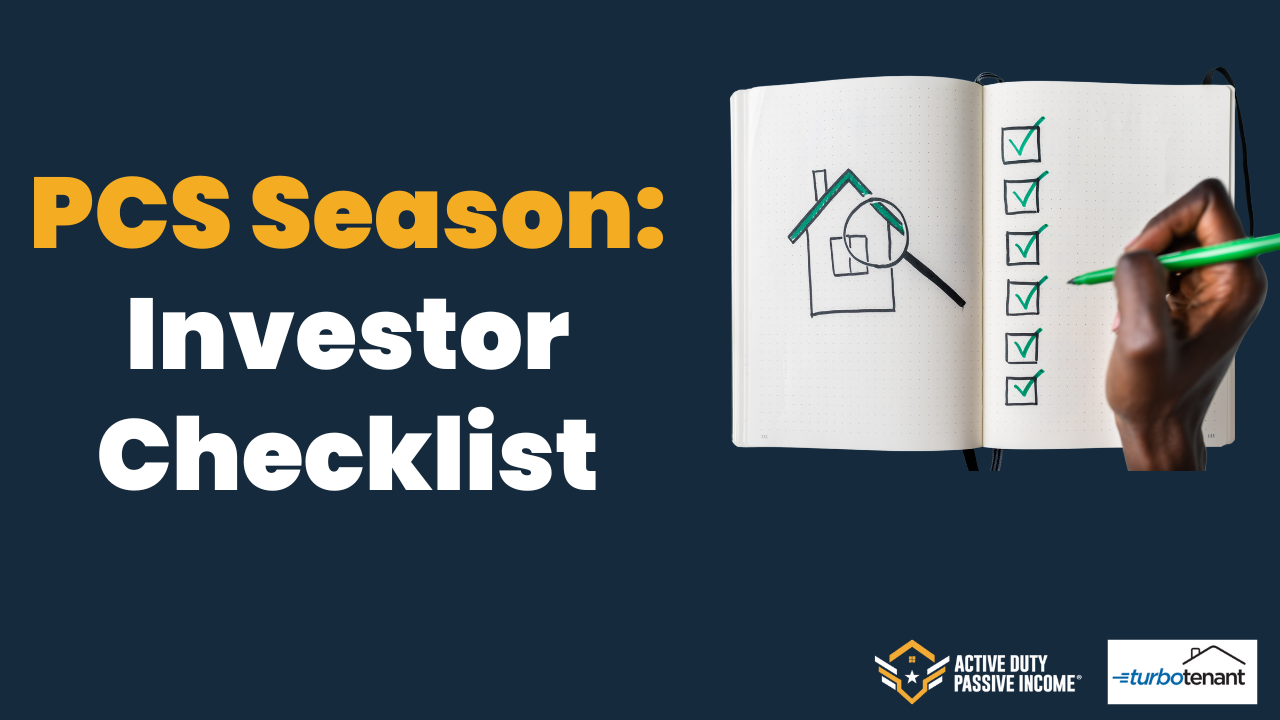It’s that time of year: PCS season! Between preparing for your move and handling orders, out-processing, and getting the family ready, it can be difficult to also juggle moving a tenant into your property.
That’s where we come in. ADPI has all the resources you need to find quality tenants ASAP so that’s one less item to worry about on your to-do list.
See our guide below for an easy way to make sure you, your family, and your rental property are ready for your PCS.
Prepping for Move-Out:
1. Clean, repair, and prep the home for new residents
Make sure you’re preparing your property to be move-in ready for future tenants. This should include tasks like testing appliances, repairing any broken amenities like blinds or ceiling fans, replacing light bulbs throughout the unit, and touching up any paint in the home.
You’ll also want to make sure the home is as clean as possible for future tenants. If you’re short on time, a cleaning service is a good option and can be deducted as a business expense on your taxes.
Not sure where to start? Reference this free guide.
2. Take quality photos for your listing
High quality photos are essential for rental advertising success. Make sure to take any photos of the unit after you’ve repaired and cleaned the space. Some other tips to keep in mind:
- Lighting: Have as much natural light in your rental as possible to enhance the quality
- Angles: Make sure you’re taking eye-level photos so renters can get a feel for what each of the rooms look like
- All rooms and amenities: Document every single room and amenity in your rental, including any outdoor or community spaces
Check out this guide on maximizing your listing for more tips.
3. Decide what furniture (if any) stays behind
Decide what furniture you are bringing with you and what you might leave behind. If you decide to leave behind furniture, there’s a couple options for what to do:
- Donate the furniture: Depending on your location, there’s likely a couple options for furniture donation. Keep in mind that most places will not accept broken or damaged items.
- Dispose of the furniture. If the furniture is too damaged or worn to be donated, you’ll need to dispose of it. There are services available for dropoff or pickup. Find more information here.
- Leave the furniture for future tenants. If you decide to go this route, make sure the furniture is clean and in good condition. The last thing tenants want is damaged or worn our furniture in their new home. Make sure to also specify to the tenants that furniture is included in the rental and verify that the information is in your lease agreement.
4. Update your insurance to reflect a rental property
Standard homeowners insurance does not cover rental properties, so you’ll need to switch to a landlord insurance policy. Landlord insurance helps protect the structure of your property, any potential liability, lost income, and damage from any natural disasters.
TurboTenant partners with Steadily Landlord Insurance, which is a great option for investors. Some homeowner’s insurance companies also offer landlord insurance.
5. Create a list of helpful info for your future resident (utilities, quirks, etc.)
To get ahead of frequently asked questions and potential emergencies, you’ll want to prepare a guide for future tenants. Some landlords call this a Welcome Home Guide.
A Welcome Home Guide typically includes important dates like when rent is due or when the lease ends, how to pay rent and what late fees are, where to pay utilities, quick fixes to common issues like switching the breaker, and contact information for emergencies.
If you use TurboTenant to manage your tenants, you can quickly generate a unique Welcome Home Guide through your lease profile. They will pull information from your lease into the guide, allowing you to create custom fields and add additional information. Once you’re done, you can text or email the guide to your tenants.
On TurboTenant:
1. Set up your free account
If you haven’t already, create a free landlord account on TurboTenant so you can find your next tenant and manage them remotely. It takes less than five minutes and is 100% free – no credit card required.
2. Build and publish your listing
Add your property to TurboTenant using their easy listing builder. All you have to do is enter in the address, property rooms and amenities, and select information about your rental from their suggested prompts.
To save even more time, take advantage of their AI tool that can generate a unique title and description for your listing in under five seconds.
3. Vet tenants
Interested leads will show up in your TurboTenant “leads” tab. Click into each one to view the results of their automatic prescreener, which will include information like target move-in date, employment status, if they have pants, and more. You can invite leads to apply to the property via TurboTenant – rental applications include a full screening report.
TurboTenant screening reports include background, credit, criminal, and eviction checks. All you need is a tenant’s phone number or email to send the application. Applications are free for landlords and range from $45 – $55 for tenants.
4. Upload or generate your lease
Once you’ve selected a tenant for your property, you’ll need a lease agreement that’s compliant with your state’s laws. If you don’t already have one, you can get one through TurboTenant by subscribing to their Premium subscription ($149/yr).
TurboTenant Premium includes free E-Signatures so you can send your lease agreement to tenants no matter where you are. Whether you’re using a TurboTenant lease or an existing lease, you’ll want to upload it to TurboTenant so you and your tenants can reference it at any time.
5. Set up rent collection
The final step to putting tenant management on autopilot is to set up rent collection. We recommend using TurboTenant’s rent collection feature, which allows tenants to pay via ACH bank transfer, debit, or credit card. You can connect your bank account(s) for automatic deposits and tenants can turn on autopay so they don’t have to manually pay each month.
TurboTenant also allows you to customize automatic late fees. Set up daily, one-time, percentage-based, or flat rate late fees to auto apply when rent goes unpaid. TurboTenant also sends rent receipts to tenants for you, which are legally required in 18 states.
Final PCS To-Dos:
By prepping your rental properly and setting up your rental to be easily managed remotely on TurboTenant, you’re set up for PCS success. Before you move, we recommend completing the following steps to make sure you’re prepared for any situation.
1. Leave a spare key or lockbox for local support
Always leave a spare key at your rental property so maintenance professionals, assistants, or tenants can access it in case of emergency. We recommend investing in a lockbox for maximum security, but you can also consider leaving a key with a trusted neighbor or in a secure hiding place.
2. Share your new contact info
Provide your tenants and local contacts with the best way to contact you. If you don’t want to share your personal email or phone number, you can use a free Google voice number or communicate through TurboTenant’s instant messaging.
3. Make a plan for ongoing maintenance
Maintenance and property upkeep are inevitable. Find a reliable maintenance professional in the area or use TurboTenant’s partnership with Thumbtack to outsource maintenance to a vetted professional in your area.
4. Bookmark your TurboTenant dashboard
Bookmark your TurboTenant dashboard so you can easily access it in seconds for tenant management. This is your hub for all rental related tasks and important documentation like lease agreements and payment history.







